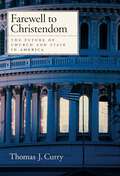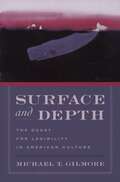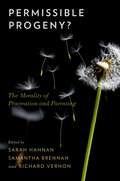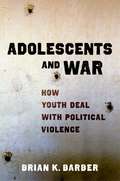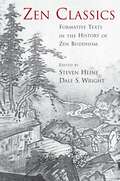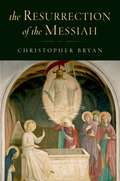- Table View
- List View
Farewell to Christendom: The Future of Church and State in America
by Thomas J. CurryThomas Curry argues that discussion and interpretation of the First Amendment have reached a point of deep crisis. Historical scholarship dealing with the background and interpretation of the Amendment are at an impasse, and judicial interpretation is in a state of disarray. Here, Curry provides a new paradigm for the understanding and exploration of religious liberty, contending that much of the present confusion can be traced to habits of mind that persist from Christendom and inevitably draw government into religious matters. The First Amendment, however, was meant to be a departure from the thinking that had preceded it for nearly fifteen hundred years. Curry traces much of the current difficulty to the largely unexamined assumption on the part of judges and scholars that the amendment created a right--the right to free exercise of religion--and that the courts are the guardians of that right. The First Amendment is, in fact, a limitation on government and a guarantee that the government will not impinge on the religious liberty that citizens already possess by natural right. Here, Curry shows that the key to finding more coherence between Church-State decisions and the historical meaning and purpose of the First Amendment lies in embracing this understanding of the Amendment as a limitation on government.
The Riddle of the World: A Reconsideration of Schopenhauer's Philosophy
by Barbara HannanThis book is an introduction to the philosophy of Arthur Schopenhauer, written in a lively, personal style. Hannan emphasizes the peculiar inconsistencies and tensions in Schopenhauer's thought--he was torn between idealism and realism, and between denial and affirmation of the individual will. In addition to providing a useful summary of Schopenhauer's main ideas, Hannan connects Schopenhauer's thought with ongoing debates in philosophy. According to Hannan, Schopenhauer was struggling half-consciously to break altogether with Kant and transcendental idealism; the anti-Kantian features of Schopenhauer's thought possess the most lasting value. Hannan defends panpsychist metaphysics of will, comparing it with contemporary views according to which causal power is metaphysically basic. Hannan also defends Schopenhauer's ethics of compassion against Kant's ethics of pure reason, and offers friendly amendments to Schopenhauer's theories of art, music, and "salvation." She also illuminates the deep connection between Schopenhauer and the early Wittgenstein, as well as Schopenhauer's influence on existentialism and psychoanalytic thought.
Law's Evolution and Human Understanding
by Laurence ClausWhen should we follow the law? How can we know what law's words mean? What is law? Law's Evolution and Human Understanding presents fresh and surprising answers to these questions. In an account alive with the stories of our shared human history, Laurence Claus explains why we should discard the old idea that legal rules tell us what to do, and instead see law as a system of sayings that evolves among humans to help us better understand each other. When driving on public roads, when buying and selling, and in countless other aspects of our work and play, we depend on law to let us know what other people are likely to do and to expect of us. Through fast-paced pages of anecdote and argument, Law's Evolution and Human Understanding explains the revolutionary consequences of seeing law as truly what Oliver Wendell Holmes called it: systematized prediction. The book reveals how this vision of law can transform our thinking about the way we make moral decisions, about the way we read law, and about many other ways that law affects our lives.
The Songs of Hollywood: The Stories Behind The Songs Of Broadway, Hollywood, And Tin Pan Alley
by Philip Furia Laurie PattersonFrom "Over the Rainbow" to "Moon River" and from Al Jolson to Barbra Streisand, The Songs of Hollywood traces the fascinating history of song in film, both in musicals and in dramatic movies such as High Noon. Extremely well-illustrated with 200 film stills, this delightful book sheds much light on some of Hollywood's best known and loved repertoire, explaining how the film industry made certain songs memorable, and highlighting important moments of film history along the way. The book focuses on how the songs were presented in the movies, from early talkies where actors portrayed singers "performing" the songs, to the Golden Age in which characters burst into expressive, integral song--not as a "performance" but as a spontaneous outpouring of feeling. The book looks at song presentation in 1930s classics with Fred Astaire and Ginger Rogers and in 1940s gems with Judy Garland and Gene Kelly. The authors also look at the decline of the genre since 1960, when most original musicals were replaced by film versions of Broadway hits such as My Fair Lady.
Coptic Christianity in Ottoman Egypt
by Febe ArmaniosIn this book, Febe Armanios explores Coptic religious life in Ottoman Egypt (1517-1798), focusing closely on manuscripts housed in Coptic archives. Ottoman Copts frequently turned to religious discourses, practices, and rituals as they dealt with various transformations in the first centuries of Ottoman rule. These included the establishment of a new political regime, changes within communal leadership structures (favoring lay leaders over clergy), the economic ascent of the archons (lay elites), and developments in the Copts' relationship with other religious communities, particularly with Catholics. Coptic Christianity in Ottoman Egypt highlights how Copts, as a minority living in a dominant Islamic culture, identified and distinguished themselves from other groups by turning to an impressive array of religious traditions, such as the visitation of saints' shrines, the relocation of major festivals to remote destinations, the development of new pilgrimage practices, as well as the writing of sermons that articulated a Coptic religious ethos in reaction to Catholic missionary discourses. Within this discussion of religious life, the Copts' relationship to local political rulers, military elites, the Muslim religious establishment, and to other non-Muslim communities are also elucidated. In all, the book aims to document the Coptic experience within the Ottoman Egyptian context while focusing on new documentary sources and on an historical era that has been long neglected.
God's Own Party: The Making of the Christian Right
by Daniel K. WilliamsWhen the Christian Right burst onto the scene in the late 1970s, many political observers were shocked. But, as God's Own Party demonstrates, they shouldn't have been. The Christian Right goes back much farther than most journalists, political scientists, and historians realize. Relying on extensive archival and primary source research, Daniel K. Williams presents the first comprehensive history of the Christian Right, uncovering how evangelicals came to see the Republican Party as the vehicle through which they could reclaim America as a Christian nation. A fascinating and much-needed account of a key force in American politics, God's Own Party is the only full-scale analysis of the electoral shifts, cultural changes, and political activists at the movement's core--showing how the Christian Right redefined politics as we know it.
The Oxford Handbook of Molecular Psychology: Oxford Handbook Of Molecular Psychology (Oxford Library of Psychology)
by Turhan CanliDetermining the biological bases for behavior, and the extent to which we can observe and explain their neural underpinnings, requires a bold, broadly defined research methodology. The interdisciplinary entries in this handbook are organized around the principle of "molecular psychology," which unites cutting-edge research from such wide-ranging disciplines as clinical neuroscience and genetics, psychology, behavioral neuroscience, and neuroethology. For the first time in a single volume, leaders in diverse research areas use molecular approaches to investigate social behavior, psychopathology, emotion, cognition and stress in healthy volunteers, patient populations, and an array of non-human species including rodents, insects, fish, and non-human primates. Chapters draw on molecular methods covering candidate genes, genome-wide association studies, copy number variations, gene expression studies, and epigenetics while addressing the ethical, legal, and social issues to emerge from this new and exciting research approach.
Surface and Depth: The Quest for Legibility in American Culture
by Michael T. GilmoreThe idea of a common American culture has been in retreat for a generation or more. Arguments emphasizing difference have discredited the grand synthetic studies that marginalized groups and perspectives at odds with the master narrative. Surface and Depth: The Quest for Legibility in American Culture is a fresh attempt to revitalize an interpretive overview. It seeks to recuperate a central tradition while simultaneously recognizing how much that tradition has occluded. The book focuses on the American zeal for knowing or making accessible. This compulsion has a long history stretching back to Puritan anti-monasticism; to the organization of the landscape into clearly delineated gridwork sections; and to the creation of a national government predicted on popular vigilance. It can be observed in the unmatched American receptivity to the motion pictures and to psychoanalysis: the first a technology of visual surfaces, the second a technique for plumbing interior depths. Popular literature, especially the Western and the detective story, has reinscribed the cult of legibility. Each genre features a plot that drives through impediments to transparent resolution. Elite literature has adopted a more contradictory stance. The landmarks of the American canon typically embark on journeys of discovery while simultaneously renouncing the possibility of full disclosure (as in Ahab's doomed pursuit of the "inscrutable" white whale). The notorious modernism of American literature, its precocious attraction to obscurity and multiple meaning, evolved as an effort to block the intrusions of a hegemonic cultural dynamic. The American passion for knowability has been prolific of casualties. Acts of making visible have always entailed the erasure and invisibility of racial minorities. American society has also routinely trespassed on customary areas of reserve. A nation intolerant of the hidden paradoxically pioneered the legal concept of privacy, but it did so in reaction to its own invasive excesses.
The Oxford Handbook of Religious Diversity (Oxford Handbooks)
There exists today a rich and abounding diversity of religions in the world-a diversity with respect to both belief and practice. But it is a diversity that poses many challenges and raises many questions, most especially in a pluralistic milieu. How do we engage in effective dialogue with religious others? What should public education reflect in a religiously pluralistic context? What role might the diversity of religions play in developing a global ethic? How do the various religious traditions deal with the plurality of religious belief and practice? What role does gender play in such discourse? The Oxford Handbook of Religious Diversity is a volume of thirty-three original chapters that cover numerous issues in religious diversity and draw readers into the heart of the current dialogue. It is divided into three parts: Contours of Religious Diversity, Key Issues Relevant to Religious Diversity, and Differing Perspectives on Religious Diversity. Chapters in the first part trace the general features of religious diversity discussions from four different fields: history, religious studies, philosophy, and sociology. Part two explores key theological, philosophical, sociological, and public policy issues relevant to religious diversity. The third and final part provides differing analyses of religious diversity from multi-faith, gender, and global points of view. An indispensable guide for scholars and students, the Handbook makes a state-of-the-art contribution to the field with essays crafted by experts representing a wide variety of religious and philosophical perspectives.
Civilized Life in the Universe: Scientists on Intelligent Extraterrestrials
by George BasallaThis book is a selective and fascinating history of scientific speculation about intelligent extraterrestrial life. From Plutarch to Stephen Hawking, some of the most prominent western scientists have had quite detailed perceptions and misperceptions about alien civilizations: Johannes Kepler, fresh from transforming astronomy with his work on the shape of planetary orbits, was quite sure alien engineers on the moon were excavating circular pits to provide shelter; Christiaan Huygens, the most prominent physical scientist between Galileo and Newton, dismissed Kepler's speculations, but used the laws of probability to prove that "planetarians" on other worlds are much like humans, and had developed a sense of the visual arts; Carl Sagan sees clearly that Huygens is a biological chauvinist, but doesn't see as clearly that he, Sagan, may be a cultural/technological chauvinist when he assumes aliens have highly developed technology like ours, but better. Basalla traces the influence of one speculation on the next, showing an unbroken but twisting chain of ideas passed from one scientist to the next, and from science to popular culture. He even traces the influence of popular culture on science--Sagan always admitted how much E. R. Burroughs' Martian novels influenced his speculations about Mars. Throughout, Basalla weaves his theme that scientific belief in and search for extraterrestrial civilizations is a complex impulse, part secularized-religious, and part anthropomorphic. He questions the common modern scientific reasoning that life converges on intelligence, and intelligence converges on one science valid everywhere. He ends the book by agreeing with Stephen Hawking (usually a safe bet) that intelligence is overrated for survival in the universe, and that we are most likely alone.
A Guide to Evidence-Based Group Work
by Mark J. MacgowanThis is the first textbook that illustrates, step by step, how to practice evidence-based group work. As group workers are increasingly being held accountable to evaluate, monitor, and improve their practice, there are scant resources available that apply specifically to their practice. General books on evidence-based practice lack the rich material on group work organized for the first time in this one volume. Designed specifically as a supplement for undergraduate and graduate group work courses, the text is organized around the process and philosophy of evidence-based practice: formulating appropriate practice questions; searching for evidence; critically reviewing available evidence; applying the evidence with judgment, skill, and concern for the group members; and evaluating the outcomes achieved. The evidence-based group work framework teaches students how to skillfully apply best practices through practical learning activities, case examples, research designs, step-by-step guidelines and checklists, assessment tips, and detailed instructions for formulating questions and evaluating answers. It will be equally valuable as a handy reference for professionals eager to hone their practice skills.
Asbestos and its Diseases
by John E. Craighead, MD and Allen R. Gibbs, MB, ChBAlthough asbestos was once considered a miracle mineral, today even the word itself has ominous implications for all strata of our society. Incorporated in the past into over 3000 different industrial and consumer products, as well as in building materials and military equipment, opportunities for exposure continue to be ever present in our environment. Of all of us who are potentially exposed, blue collar workers are at greatest risk. Countless thousands of workers and servicemen in a wide variety of trades were disabled or have died consequent to the health effects of asbestos, and many more can be expected to be affected in years to come. Litigation continues, and financial awards in the billions have bankrupt many Fortune 500 companies and numerous smaller companies. While one might implicate our forefathers in this widespread, relentless medical catastrophe, it has been only in recent decades that science has appreciated the complexities of the problem and the long latencies before the asbestos-associated diseases appear clinically. After all these years, prevention remains the hallmark of disease control, as modern treatments remain, to a large extent, futile.
Child Poverty and Inequality: Securing a Better Future for America's Children
by Duncan LindseyOne of the United States great promises is that all children will be given the opportunity to work to achieve a comfortable standard of living. That promise has faded profoundly for children who grow up in poverty, particularly black and Hispanic children, and many of the deepening fault lines in the social order are traceable to this disparity. In recent years the promise has also begun to fade for children of the middle class. Education and hard work, once steady paths to economic success, no longer lead as far as they once did. But that doesn't have to be the case, as Duncan Lindsey shows in this articulate, impassioned volume. We can provide true opportunity to all children, insuring them against a lifetime of inequality, and when we do, the walls dividing the country by race, ethnicity, and wealth will begin to crumble. Long a voice for combating child poverty, Lindsey takes a balanced approach that begins with a history of economic and family policy from the Great Depression and the development of Social Security and moves onward. He details the shocking extent of economic inequality in the U.S., pointing out that this wealthiest of countries also has the largest proportion of children living in poverty. Calling for reform, Lindsey proposes several viable universal income security policies for vulnerable children and families, strategies that have worked in other advanced democracies and also respect the importance of the market economy. They aim not just to reduce child poverty, but also to give all children meaningful economic opportunity. Just as Social Security alleviates the sting of poverty in old age, asset-building policies can insulate children from the cumulative effects of disadvantage and provide them with a strong foundation from which to soar. Politicians, pundits, and parents always say that children are the future, but as long as so many grow up poor or without opportunity, that slogan will sound hollow. Duncan Lindseys book should be read by anyone who wants to know how we can take real action to brighten the future for children and for society as a whole.
Interpreting Epidemiologic Evidence: Strategies for Study Design & Analysis
by David A. SavitzEvaluating the strength or persuasiveness of epidemiologic evidence is inherently challenging, both for those new to the field and for experienced researchers. There are a myriad of potential biases to consider, but little guidance about how to asses the likely impact on study results. This book offers a strategy for assessing epidemiologic research findings, explicitly describing the goals and products of epidemiologic research in order to better evaluate it successes and limitations. The focus throughout is on practical tools for making optimal use of available data to assess whether hypothesized biases are operative and to anticipate concerns at the point of study design in order to ensure that needed information is generated. Specific tools for assessing the presence and impact of selection bias in both cohort and case-control studies, bias from non-response, confounding, exposure measurement error, disease measurement error, and random error are identified and evaluated. The potential value of each approach as well as its limitations are discussed, using examples from the published literature. Such information should help those who generate and interpret epidemiologic research to apply methodological principles more effectively to substantive issues, leading to a more accurate appraisal of the current evidence and greater clarity about research needs.
Permissible Progeny?: The Morality of Procreation and Parenting
by Edited by Sarah Hannan ,This volume contributes to the growing literature on the morality of procreation and parenting. About half of the chapters take up questions about the morality of bringing children into existence. They discuss the following questions: Is it wrong to create human life? Is there a connection between the problem of evil and the morality of procreation? Could there be a duty to procreate? How do the environmental harms imposed by procreation affect its moral status? Given these costs, is the value of establishing genetic ties ever significant enough to render procreation morally permissible? And how should government respond to peoples' motives for procreating? The other half of the volume considers moral and political questions about adoption and parenting. One chapter considers whether the choice to become a parent can be rational. The two following chapters take up the regulation of adoption, focusing on whether the special burdens placed on adoptive parents, as compared to biological parents, can be morally justified. The book concludes by considering how we should conceive of adequacy standards in parenting and what resources we owe to children. This collection builds on existing literature by advancing new arguments and novel perspectives on existing debates. It also raises new issues deserving of our attention. As a whole it is sure to generate further philosophical debate on pressing and rich questions surrounding the bearing and rearing of children.
Reputation: A Network Interpretation
by Kenneth H. CraikThis book argues that a network interpretation of reputation advances our understanding of an essential and inescapable feature of social life and integrates many of its' varied facets. Reputation is a dispersed phenomenon that is to be found in the beliefs and assertions of an extensive number of other individuals. Reputation is part of the environment but uniquely referenced to a specific person. Discussions concerning reputation are often vague with regard to who are those others holding beliefs or making assertions about a person and thereby contributing to that person's reputation, with reference perhaps to 'people in general' or 'society at large.' A network model of reputation generates conceptual innovations that have systematic implications for such diverse disciplines as network theory and social network analysis, gossip research, person perception and cognition, social representation research, personality theory and assessment, publicity and public relations, libel law, biographical studies, and cultural history. Craik argues that reputation is not simply a central topic for the study of social life. Rather, it holds the potential to sustain an interdisciplinary field of inquiry in its own right.
Adolescents and War: How Youth Deal with Political Violence
by Brian K BarberHundreds of thousands of children are forced or legally recruited combatants in no fewer than 70 warring parties across the world. In addition to these child soldiers, thousands of youth voluntarily participate in politically related conflict. Why, how, and in what capacities are such large numbers of teenagers involved in war and how are they affected? Adolescents and War brings together world experts in an evidence-based volume to thoroughly understand and document the intricacies of youth who have had substantial involvement in political violence. Contributors argue that the assumption that youth are automatically debilitated by the violence they experience is much too simplistic: effective care for youth must include an awareness of their motives and beliefs, the roles they played in the conflict, their relationships with others, and the opportunities available to them after their experiences with war. The book suggests that the meaning youth make of a conflict may protect them from mental harm. For example, Palestinian teens who were actively engaged in the first Intifada have fared better than Bosnian teens who were virtual sitting ducks to the sniper and grenade launches of the hidden forces during the siege of Sarajevo. Covering youth involvement in conflicts in Afghanistan, Angola, Sierra Leone, Mozambique, Northern Ireland, Israel/Palestine, and Bosnia, the volume will be of interest to psychologists, sociologists, and political scientists and should be adopted for courses in social psychology, crisis intervention, and international conflict.
Zen Classics: Formative Texts in the History of Zen Buddhism
by Steven Heine Dale S. WrightThis is a companion volume to The Koan and The Zen Canon, by the same editors. The first volume collected original essays on koan collections, recorded sayings of individual masters, histories of major schools, and compilations of monastic regulations. The second focuses on the early history of Zen in China, providing overview assessments of many of the most important canonical texts that set the Zen tradition in motion throughout East Asia. Zen Classics will follow that historical movement, focusing primarily on texts from Korea and Japan that brought this Buddhist movement to fruition. Although enormously diverse in style and structure all of the texts and genres of texts considered here were fundamental to the unfolding of Zen in East Asia. The range of genres reveals the varieties of Zen practice, from rules of daily practice to sermons and meditation manuals. The all new essays in this volume will be contributed by an international team of distinguished scholars of Buddhism. It is aimed at broad audience including college students, Zen practitioners, and scholars of East Asian history, religion, and culture, as well as specialists in Buddhist history.
Music Outside the Lines: Ideas for Composing in K-12 Music Classrooms
by Maud HickeyMusic Outside the Lines is an informative and practical resource for all who are invested in making music composition an integral part of curriculum. Author Maud Hickey offers both a well-grounded justification for teaching music composition and also a compendium of useful instructional ideas and classroom activities. Hickey begins with a rationale for teachers to begin composition activities in their own classrooms, with a thoughtful argument that demonstrates that all music teachers possess the skills and training needed to take children along the path toward composing satisfying musical compositions even if they themselves have never taken formal composition lessons. She also addresses some of the stickier issues that affect teaching music composition in schools such as assessment, notation, and technology. Most importantly, she introduces a curricular model for teaching composition, a model which provides an array of composition activities to try in both the music classrooms and studio. These activities encourage musical and creative growth through music composition; while they are organized in logical units corresponding to well-known teaching modules, they also offer jumping off points for music teachers to exercise their own creative thinking and create music composition activities that are customized to their classes and needs. As a whole, Music Outside the Lines both successfully reasons that music composition should be at the core of school music curriculum and also provides inservice and preservice educators with an essential resource and compendium of practical tips and plans for fulfilling this goal.
No Accident, Comrade: Chance and Design in Cold War American Narratives
by Steven BellettoNo Accident, Comrade argues that chance became a complex yet conflicted cultural signifier during the Cold War, when a range of thinkers--politicians, novelists, historians, biologists, sociologists, and others--contended that totalitarianism denied the very existence and operation of chance in the world. They claimed that the USSR perpetrated a vast fiction on its population, a fiction amplified by the Soviet view that there is no such thing as chance or accident, only manifestations of historical law (hence the popular American refrain used to refer to Marxism: "It was no accident, Comrade"). By reading an expansive range of American novels published between 1947-2005, alongside nonfiction texts by the likes of Jerzy Kosinski, Daniel Bell, Ian Hacking, and mid-century game theorists, No Accident, Comrade explains how associations of chance with democratic freedom and the denial of chance with totalitarianism circulated in Cold War America. Chance became tied to the liberties of U.S. democracy, whereas its eradication or denial became symptomatic of Soviet tyranny. With works by Nabokov, Ellison, Pynchon, Didion, DeLillo, Colson Whitehead, and many others, Steven Belletto shows how writers developed innovative strategies for dealing with and incorporating these ever-present beliefs about chance and its role in their culture. These newly developed narrative techniques allowed them to theorize, satirize, and make sense of the constantly changing relationship between the individual and the state during a largely rhetorical conflict.
The Oxford Handbook of Epistemology (Oxford Handbooks)
by Paul K. MoserThe Oxford Handbook of Epistemology contains 19 previously unpublished chapters by today's leading figures in the field. These chapters function not only as a survey of key areas, but as original scholarship on a range of vital topics. Written accessibly for advanced undergraduates, graduate students, and professional philosophers, the Handbook explains the main ideas and problems of contemporary epistemology while avoiding overly technical detail.
Stress, Trauma, and Children's Memory Development: Neurobiological, Cognitive, Clinical, and Legal Perspectives
by Mark L. Howe, Gail S. Goodman, And Dante CicchettiFew questions in psychology have generated as much debate as those concerning the impact of childhood trauma on memory. A lack of scientific research to constrain theory has helped fuel arguments about whether childhood trauma leads to deficits that result in conditions such as false memory or lost memory, and whether neurohormonal changes that are correlated with childhood trauma can be associated with changes in memory. Scientists have also struggled with more theoretical concerns, such as how to conceptualize and measure distress and other negative emotions in terms of, for example, discrete emotions, physiological response, and observer ratings. To answer these questions, Mark L. Howe, Gail Goodman, and Dante Cicchetti have brought together the most current and innovative neurobiological, cognitive, clinical, and legal research on stress and memory development. This research examines the effects of early stressful and traumatic experiences on the development of memory in childhood, and elucidates how early trauma is related to other measures of cognitive and clinical functioning in childhood. It also goes beyond childhood to both explore the long-term impact of stressful and traumatic experiences on the entire course of "normal" memory development, and determine the longevity of trauma memories that are formed early in life. Stress, Trauma, and Children's Memory Development will be a valuable resource for anyone interested in early experience, childhood trauma, and memory research.
The Practice of International Health: A Case-Based Orientation
by Daniel PerlmanVirtually every school of public health teaches a global health course, yet the major textbooks provide little on the actual practice of international health. This new book comprises a series of vivid first person accounts in which physicians, epidemiologists, health workers, and public health professionals from around the world present the critical dilemmas and challenges facing the field. Aimed primarily at medical and public health students and professionals, this book will be a much-needed addition to the existing literature. Related fields, such as development and urban studies, will find this book an engaging introduction to the core issues of international development. International health practitioners, national and local policymakers, foundations officers, and other related professionals will also find it an invaluable compendium. "The Practice of International Health is a beautifully conceived and beautifully written book. It offers an inspiring example of what may be accomplished when scholars with field experience break free of rigid disciplinary boundaries in order to examine key problems in international health. This case-based approach is precisely the one that will allow us to build a new field based on broad understandings of these problems and on the solutions that might follow. The need for and vibrant potential of such a focus on practice that resonates in every page of this book signals its profound relevance to students and teachers of public health, and, one hopes, to policy makers and funders." From the Foreward by Paul Farmer
The Resurrection of the Messiah
by Christopher BryanIn The Resurrection of the Messiah, Christopher Bryan combines literary, historical, and theological approaches in a study of the doctrine of the Resurrection. The book is divided into three parts. The first section provides a careful and sympathetic description of first-century Jewish and pagan opinions and beliefs about death and what might follow. This is followed by a presentation of a general account of early Christian claims about the death and resurrection of Jesus of Nazareth. The second part of the book offers a detailed, full-length commentary on and exegesis of the main New Testament texts that speak of Jesus' death and resurrection: 1 Corinthians 15 and the narratives in the four canonical gospels. As a framework for this commentary, Bryan utilizes the pattern of apostolic preaching presented by Paul and then echoed by each of the four evangelists, namely the formula "Christ died, Christ was buried, Christ has been raised, Christ appeared." The final section of the book is spent discussing and evaluating various proposals that have been made by those attempting to explain the data in ways that differ from the traditional Christian explanation. Bryan also considers various theological and ethical implications of accepting the claim "Jesus Christ has been raised from the dead." Throughout his study, Bryan exhibits a willingness to face hard questions as well as an appropriate reverence for a faith that for almost two thousand years has enabled millions of people to lead lives of meaning and grace.
Rastafari: From Outcasts to Cultural Bearers
by Ennis Barrington EdmondsOnce an obscure group of outcasts from the ghettoes of West Kingston, Jamaica, the Rastafarians have transformed themselves into a vibrant movement, firmly grounded in Jamaican society and beyond. In Rastafari, Ennis Barrington Edmonds provides a compelling portrait of the Rastafarian phenomenon and chronicles how this group, much maligned and persecuted, became a dominant cultural force in the world today. Edmonds charts the evolution of the relationship between Rastafari and the wider Jamaican society, from confrontation and repression to grudging tolerance and eventually to cultural integration. Edmonds focuses in particular on the internal development of Rastafarianism as a social movement, with its network of "houses" (small, informal groups that form around leading Rastas) and "mansions" (larger, more communal associations), to track the process of this strikingly successful integration. He further demonstrates how Rastafarian artistic creativity, especially in fashioning the music and message of reggae, was a significant factor in the transition of Rastas from the status of outcasts to the position of cultural bearers.
